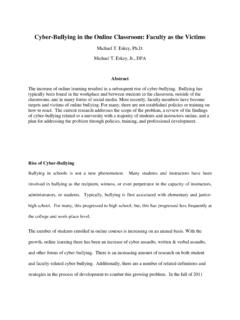Transcription of What is Cyberbullying?
1 what is cyberbullying ? cyberbullying refers to bullying through information and communication technologies, mediums such as mobile phone text messages, emails, phone calls, internet chat rooms, instant messaging and the latest trend social networking websites such as MySpace, Facebook and Bebo. cyberbullying is a fast growing trend that experts believe is more harmful than typical schoolyard bullying . Nearly all of us can be contacted 24/7 via the internet or our mobile phones. Victims can be reached anytime and anyplace. For many children, home is no longer a refuge from the bullies. Children can escape threats and abuse in the classroom, only to find text messages and emails from the same tormentors when they arrive home.. There's no safe place anymore.
2 You can be bullied 24 in the privacy of your own bedroom. 1. Recent surveys have shown that one-third of teenagers have had mean, threatening or embarrassing things said about them online2. 10 percent of teenagers were threatened online with physical harm. 16 percent of teenagers who were victims told no one about it3. Online social networking sites have become increasingly popular with children, especially young teens, as a place where they can meet other people, communicate, and exchange No type of bullying is harmless. In some cases, it can constitute criminal behaviour. In extreme incidents, cyberbullying has led teenagers to suicide. Most victims, however, suffer shame, embarrassment, anger, depression and withdrawal. cyberbullying is often seen as anonymous, and the nature of the internet allows it to spread quickly to hundreds and thousands of people.
3 cyberbullying has the same insidious effects as any kind of bullying , turning children away from school, friendships, and in tragic instances, life itself. 5. Parents often tell their children to turn off the mobile phones or stay off the computer. Many parents don't understand that the internet and mobile phone act as a social lifeline for teenagers to their peer group. Victims often don't tell their parents because they think their parents will only make the problem worse, or that they might even confiscate their mobile phone or take away their internet access removing that social lifeline. While bullying is something that is often under the radar' of adults, cyberbullying is even more so. Teenagers are increasingly communicating in ways that are often unknown by adults and away from their supervision.
4 They organise their social lives through these mediums. Their friendships are made and broken over these mediums. The challenge is in raising awareness to such a level that people victims and witnesses will feel comfortable enough to speak up. 6. So what can we do about it?' many people wonder. Education and awareness is the key. Parents and teachers need to understand the problem, and understand the technology. In an age of influences such as reality TV programmes, where participants are harassed and ridiculed, children need to understand that this is not the way they should relate to each other. If awareness of these issues is raised to such a level among their parents, teachers and friends, children will begin to feel that they can talk about cyberbullying , and the problem will come out of the mobile phone inboxes, out of the computers and into the open.
5 A third of those who experience cyberbullying do not report it. If we are to succeed in preventing bullying , we need to break the climate of silence in which it thrives by empowering children and young people to speak out and seek help. 7. 1. Electronic bullying , 2005, Dolly, April, Issue 414, page 90. 2. Electronic bullying , 2005, Dolly, April, Issue 414, page 90. 3. "Putting U in the picture - Mobile bullying survey 2005", NCH and Tesco Mobile, produced June 2005 < >. 4. Massachusetts Attorney General, 2006, AG Reilly warns parents about the potential dangers of children using social networking Chris Webster sites such as MySpace and Xanga , < >, viewed 15th November 2006. 5. what can schools do about cyberbullying ? , 2005, Principals' Digests, Volume 11 Number 19.
6 Published Hamilton, New Zealand m: + 61 416 003 881. 6. 7. McDougall, B, "Victim of a cyberbully", The Daily Telegraph, Sydney, 23rd February 2005, pg. 29 e: BBC News. (2006, July 25). Government acts on cyber-bullies. Retrieved May 15, 2007, from BBC News | Education: < >. Thumbs down: Cyberbullies used with permission, All other images (c) Christopher Webster 2004-2007






